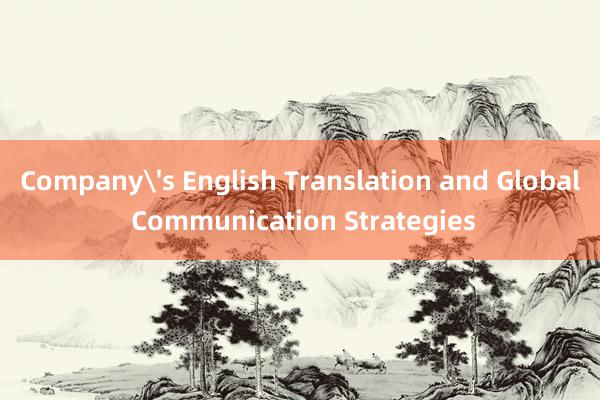Company's English Translation and Global Communication Strategies

### Company's English Translation and Global Communication Strategies
In the era of globalization, businesses are no longer confined to their local markets; they must navigate a world where competition is fierce, cultural differences are vast, and the need for effective communication across languages and cultures is paramount. This article delves into the importance of accurate English translation and strategic global communication in enhancing a company's international presence and fostering meaningful connections with diverse audiences.
#### The Role of English Translation
English has emerged as the de facto language of international business due to its widespread use and influence. A company's ability to communicate effectively in English can significantly impact its global reputation and market access. Accurate and culturally sensitive translations are crucial:
1. **Cultural Sensitivity:** Translations must not only convey the literal meaning but also adapt the content to resonate with the cultural nuances of the target audience. For instance, idiomatic expressions or colloquialisms may need to be rephrased to maintain their intended impact.
2. **Legal Compliance:** In industries such as finance, healthcare, and law, translations must adhere to legal standards and regulations of different countries, ensuring that all documents, 乙乙丁安心征信有限公司 contracts, 个人展示 and communications are legally sound and culturally appropriate.
企玖信有限公司3. **Enhancing Brand Image:** A well-translated brand message can reinforce a company’s image as a global player,<事業再構築補助金申請支援代行サービス>のご案内 | 株式会社 M41 demonstrating attention to detail and respect for international audiences.
#### Global Communication Strategies
Effective global communication strategies involve more than just translation. They encompass a holistic approach that considers the unique needs and preferences of each target market:
1. **Local Language Use:** Beyond translation, employing local languages in marketing materials,享东源码测试 customer service, and social media can significantly improve engagement and trust among local consumers.
2. **Cultural Adaptation:** Content should be adapted to reflect cultural norms, values, and sensitivities. This might involve adjusting visual elements, tone, and messaging to align with local expectations.
3. **Multilingual Teams:** Building a multilingual team within the company ensures that internal communication is seamless and that external communications are culturally informed and linguistically accurate.
4. **Technology Integration:** Utilizing translation management systems (TMS) and machine translation tools can enhance efficiency and consistency across various communication channels while maintaining quality.
5. **Feedback Mechanisms:** Implementing feedback loops allows companies to refine their global communication strategies based on real-time insights from their global audience, ensuring that messages are resonating effectively and appropriately.
#### Conclusion
In today’s interconnected world, companies that master the art of English translation and adopt robust global communication strategies stand to gain significant competitive advantages. By focusing on cultural sensitivity享东源码测试, legal compliance, and leveraging technology, businesses can effectively bridge linguistic and cultural gaps, fostering stronger relationships with customers and partners worldwide. As the global market continues to expand, these strategies will become increasingly critical for success.
